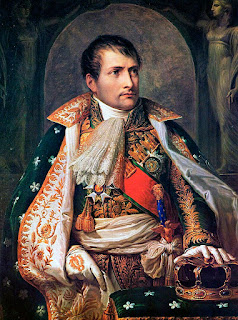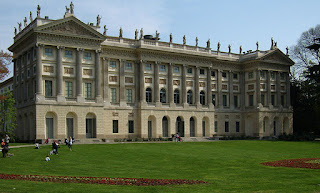Silvio Berlusconi resigns as PM
Financial crisis brings down 'untouchable' premier
Silvio Berlusconi resigned as prime minister of Italy on this day in 2011. A controversial, polarising figure, he had dominated Italian politics for 17 years. With Italy in the grip of the economic crisis that had brought severe consequences to other parts of the Eurozone, Berlusconi lost his parliamentary majority a few days earlier and promised to resign when austerity measures demanded by Brussels were passed by both houses of the Italian parliament. The Senate had approved the measures the day before. When the lower house voted 380-26 in favour, Berlusconi was true to his word, meeting president Giorgio Napoletano within two hours to tender his resignation. His last journey from the Palazzo Chigi to the Palazzo Quirinale, the respective official residences of the prime minister and the president, was not a dignified one. When he arrived at the Quirinale, he was booed by a large and somewhat hostile crowd that had gathered, entering the building to shouts of 'buffoon' and 'mafioso'. A gathering of musicians and singers serenaded him with a version of the Hallelujah Chorus from Handel's Messiah. After the meeting concluded, he left by a side entrance to avoid further barracking. Read more…
________________________________________
Giro di Lombardia - historic cycle race
2021 edition was 115th since inception
The Giro di Lombardia cycle race - now known simply as Il Lombardia - was contested for the first time on this day in 1905. The last of the cycling calendar’s five ‘Monuments’ - the races considered to be the oldest, hardest and most prestigious of the one-day events in the men's road cycling programme - the Giro di Lombardia is has also been called the Autumn Classic or la classica delle foglie morte - the classic of the dead (falling) leaves. It is a particular favourite with cyclists who excel on hill climbs, its changing route normally featuring five or six notable ascents, of which the Madonna del Ghisallo, the site of a church that has become a sacred place in the cycling world, is a permanent fixture. The race was the idea of journalist Tullio Morgagni, well known as the founder of the Giro d’Italia, although the Giro di Lombardia predated the former by three years. The editor of the Milan newspaper La Gazzetta dello Sport came up with the idea to give Piero Albini, a Milanese rider, an opportunity to avenge his defeat by rival Giovanni Cuniolo in an event called the Italian King’s Cup. For the first two years of its life, the race was simply called Milano-Milano, reflecting the fact that it started and ended in the regional capital. Read more…
_______________________________________
Piero Terracina - death camp survivor
Roman lived to be 91 after being freed from Auschwitz
Piero Terracina, the man thought to be the longest survivor among the Jews rounded up for deportation in Rome after Nazi occupation during World War Two, was born on this day in 1928 in the Italian capital. Terracina was taken to the notorious Auschwitz death camp in Poland, where almost one million Jewish prisoners were killed, but was spared death and eventually liberated in 1945. After a long and difficult recovery he returned to Rome and lived to be 91. For the last almost 30 years of his life, so long as his health allowed, he devoted himself to maintaining awareness of the Holocaust in the hope that such horrors would never be repeated. Terracina enjoyed a relatively uneventful early childhood. Although many of Rome’s Jews still lived in the area of Rione Sant’Angelo to which they had been originally confined by papal decree in the 16th century, the Jewish community in the early part of the 20th century enjoyed the same status as any other Italians in the city. Piero was the youngest of four children born to Giovanni Terracina and Lidia Ascoli. His father was a fabric merchant. Read more…
______________________________________
Flying ace survived war to look after health of Italy’s politicians
Credited with five aerial victories during the First World War, the pilot Giulio Lega was born on this day in 1892 in Florence. After the war he completed his medical studies and embarked on a long career as physician to Italy’s Chamber of Deputies. Lega had been a medical student when he was accepted by the Italian army for officer training in 1915. Because he was unusually tall, he became an ‘extended infantryman’ in the Grenadiers. He made his mark with them at the Fourth Battle of the Isonzo, for which he was awarded the War Merit Cross for valour. The following year he won a Bronze Medal for Military Valour in close-quarters combat, which was awarded to him on the battlefield. Lega volunteered to train as a pilot in 1916 and was sent to Malpensa near Milan. After gaining his licence he was sent on reconnaissance duty during which he earned a Silver Medal for Military Valour. After completing fighter pilot training he joined 76a Squadriglia and went on to fly 46 combat sorties with them. His first two victories in the air, near Col d’Asiago and over Montello, were shared with two other Italian pilots. During the last Austro-Hungarian offensive he downed a Hansa-Brandenburg C1 over Passagno single-handedly. Read more…
______________________________________
Umberto Giordano - opera composer
Death of the musician remembered for Andrea Chenier
Composer Umberto Giordano died on this day in 1948 in Milan at the age of 81. He is perhaps best remembered for his opera, Andrea Chenier, a dramatic work about liberty and love during the French Revolution, which was based on the real life story of the romantic French poet, André Chenier. The premiere of the opera was held at Teatro alla Scala in Milan in 1896. At the time, its success propelled Giordano into the front rank of up-and-coming Italian composers alongside Pietro Mascagni, to whom he is often compared, and Giacomo Puccini. Another of Giordano’s works widely acclaimed by both the public and the critics is the opera Fedora. This had its premiere in 1898 at the Teatro Lirico in Milan. A rising young tenor, Enrico Caruso, played the role of Fedora’s lover, Loris. The opera was a big success and is still performed today. Some of Giordano’s later works are less well-known but they have achieved the respect of the critics and music experts and are occasionally revived by opera companies. Giordano was born in Foggia in Puglia in August 1867. He studied under Paolo Serrao at the Conservatoire of Naples. Read more…
______________________________________
Treaty of Rapallo 1920
Agreement solves dispute over former Austrian territory
The Treaty of Rapallo between Italy and the Serbs, Croats and Slovenes was signed on this day in 1920 in Rapallo near Genoa in Liguria. It was drawn up to solve the dispute over territories formerly controlled by Austria in the upper Adriatic and Dalmatia, which were known as the Austrian Littoral. There had been tension between Italy and the Serbs, Croats and Slovenes since the end of the First World War when the Austro-Hungarian empire was dissolved. Italy had claimed the territories assigned to it by the secret London Pact of 1915 between Italy and the Triple Entente. The Pact, signed on 26 April 2015, stipulated that in the event of victory in the First World War, Italy was to gain territory formerly controlled by Austria in northern Dalmatia. These territories had a mixed population but Slovenes and Croats accounted for more than half. The London Pact was nullified by the Treaty of Versailles at the end of the war after pressure from American President Woodrow Wilson. Therefore the objective of the Treaty of Rapallo two years later was to find a compromise. Read more…
______________________________________
Book of the Day: Silvio Berlusconi: Television, Power and Patrimony, by Paul Ginsborg
Silvio Berlusconi, a self-made man with a taste for luxurious living, owner of a huge television empire and the politician who likened a German MEP to a Nazi concentration camp guard – small wonder that much of democratic Europe and America has responded with considerable dismay and disdain to his governance of Italy. Paul Ginsborg, contemporary Italy's foremost historian, explains here why we should take Berlusconi seriously. Silvio Berlusconi: Television, Power and Patrimony combines historical narrative - Berlusconi's childhood in the dynamic and paternalist Milanese bourgeoisie, his strict religious schooling, a working life which has encompassed crooning, large construction projects and the creation of a commercial television empire - with careful analysis of Berlusconi's political development. While highlighting the particular italianità of Berlusconi's trajectory, Ginsborg also finds international tendencies, such as the distorted relationship between the media system and politics. Throughout, Ginsborg suggests that Berlusconi has gotten as far as he has thanks to the wide-open space left by the strategic weaknesses of modern left-wing politics.Paul Ginsborg, author of the highly acclaimed books A History of Contemporary Italy and Italy and Its Discontents, teaches history at Florence University.
.jpg)

.jpg)


















.jpg)




.jpg)
.jpg)




.jpg)

.jpg)






